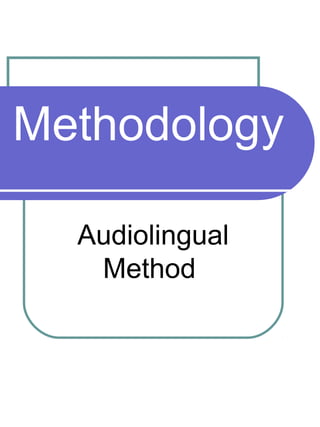
Audiolingualism
- 2. Historical Information (1) The "Army Method" developed to build communicative competence in translators through very intensive language courses focusing on aural/oral skills. Descriptive linguistics and behavioral psychology Incorporated features typical of the earlier Direct Method “Firmly grounded in linguistic and psychological theory" (Brown 1994:57 Major influence on the language teaching methods that were to follow
- 3. Historical Information (2) "quick success" it achieved in leading learners towards communicative competence Through extensive mimicry, memorization and "over-learning" of language patterns and forms, students and teachers were often able to see immediate results.
- 4. Objectives Just as with the Direct Method that preceded it, the overall goal of the Audiolingual Method was to create communicative competence in learners. However, it was thought that the most effective way to do this was for students to "overlearn" the language being studied through extensive repetition and a variety of elaborate drills. The idea was to project the linguistic patterns of the language (based on the studies of structural linguists) into the minds of the learners in a way that made responses automatic and "habitual". To this end it was held that the language "habits" of the first language would constantly interfere, and the only way to overcome ths problem was to facilitate the learning of a new set of "habits" appropriate linguistically to the language being studied.
- 5. Key Features (1) (1) New material is presented in dialog form. (2) There is dependence on mimicry, memorization of set phrases, and overlearning. (3) Structures are sequenced by means of contrastive analysis and taught one at a time. (4) Structural patterns are taught using repetitive drills. (5) There is little or no grammatical explanation. Grammar is taught by inductive analogy rather than deductive explanation. (6) Vocabulary is strictly limited and learned in context.
- 6. Key Features (2) (7) There is much use of tapes, language labs, and visual aids. (8) Great importance is attached to pronunciation. (9) Very little use of the mother tongue by teachers is permitted. (10) Successful responses are immediately reinforced. (11) There is great effort to get students to produce error-free utterances. (12) There is a tendency to manipulate language and disregard content.
- 7. Typical Techniques (1) (1) Dialog Memorization (Students memorize an opening dialog using mimicry and applied role-playing) (2) Backward Build-up (Expansion Drill) (Teacher breaks a line into several parts, students repeat each part starting at the end of the sentence and "expanding" backwards through the sentence, adding each part in sequence) (3) Repitition Drill (Students repeat teacher's model as quickly and accurately as possible) (4) Chain Drill (Students ask and answer each other one-by-one in a circular chain around the classroom ) (5) Single Slot Substitution Drill (Teacher states a line from the dialog, then uses a word or a phrase as a "cue" that students, when repeating the line, must substitute into the sentence in the correct place) (6) Multiple-slot Substitution Drill (Same as the Single Slot drill, except that there are multiple cues to be substituted into the line)
- 8. Typical Techniques (2) (7) Transformation Drill (Teacher provides a sentence that must be turned into something else, for example a question to be turned into a statement, an active sentence to be turned into a negative statement, etc) (8) Question-and-answer Drill (Students should answer or ask questions very quickly) (9) Use of Minimal Pairs (Using contrastive analysis, teacher selects a pair of words that sound identical except for a single sound that typically poses difficulty for the learners - students are to pronounce and differentiate the two words) (10) Complete the Dialog (Selected words are erased from a line in the dialog - students must find and insert) (11) Grammar Games (Various games designed to practice a grammar point in context, using lots of repetition)
- 9. Critics´ Views Cognitive psychologists developed new views on learning in general, arguing that mimicry and rote learning could not account for the fact that language learning involved affective and interpersonal factors, that learners were able to produce language forms and patterns that they had never heard before.
- 10. Critics´ Views Cognitive psychologists developed new views on learning in general, arguing that mimicry and rote learning could not account for the fact that language learning involved affective and interpersonal factors, that learners were able to produce language forms and patterns that they had never heard before.
